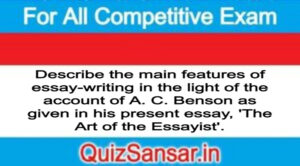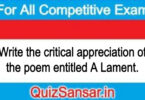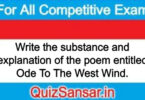
Describe the main features of essay-writing in the light of the account of A. C. Benson as given in his present essay, ‘The Art of the Essayist’.
Describe the main features of essay-writing in the light of the account of A. C. Benson as given in his present essay, ‘The Art of the Essayist’.
Or
Describe briefly Montaigne’s contribution to the modern essay.
Or
There is much similarity between the essay and the lyric. Discuss it briefly in your own words.
Ans.
Introduction
It is necessary to mention that the true essay includes the charm of the personality of the essayist because both, charm of the essay as well as the charm of his personality are very closely related together. The subject-matter of the essay is flexible along with its wide variety of the choice of the subject-matter. The writer makes it very clear that the real essay should not be scholarly, philosophical or spiritual but it is always the same without any restrictions. It is very important that the true essayist must clearly understand the subject-matter and he should enjoy it in order to express his ideas with clarity and gusto.
Montaigne’s contribution to the modern essay
It is necessary to mention that Montaigne, the great and famous French essayist had done significant work in field of the modern essay. He made it very clear that all types of expression and communication have their prototypes in literature and the essay is not free from them because it is the reverse or the frame of mind with mutual communication with oneself, not with others. We find it clearly expressed in Montaigne’s preface to his essays:
“If my object had been to seek the world’s favour, I should have decked myself with borrowed ornaments. But my wish is to be seen simply in my own fashion, natural and ordinary, unstudied and without artifice for it is myself that I am painting.”
While describing about himself in his essay the essayist shows some type of shamelessness which is clear from another sentence from Montaigne’s Preface:
“And if I had belonged to one of those Nations who are said to live under the gentle freedom of the primitive laws of Nature, I do assure you that I would very willingly have drawn myself entire and naked.”
The English essayists followed into the footsteps of Montaigne in their own style and they kept alive the main gist of essay writing with personal sensation and impression as the result of something strange or beautiful.
The essay is in common with the lyric
It is very necessary to mention that the essay has much in common with the lyric but with greater freedom and larger range and with greater element of humour which is not found in a lyric. The subject of the essay is treated in a light manner with the appeal of a poem along with some emotions. It does not show any lack of wisdom in it but the egotism of the essay shows its justification related to the writer’s experience as an example. The essay does not show any clear classification but it is, “a little piece with a theme, not very strict perhaps in form, but which can be fancifully treated, modulated from, and coloured at will. It is a little criticism of life at some one point clearly enough defined.”
-
Write the critical appreciation of the poem No. 12 entitled Far Below Flowed.
-
Write the critical appreciation of the poem No. 11 entitled Leave this Chanting.






